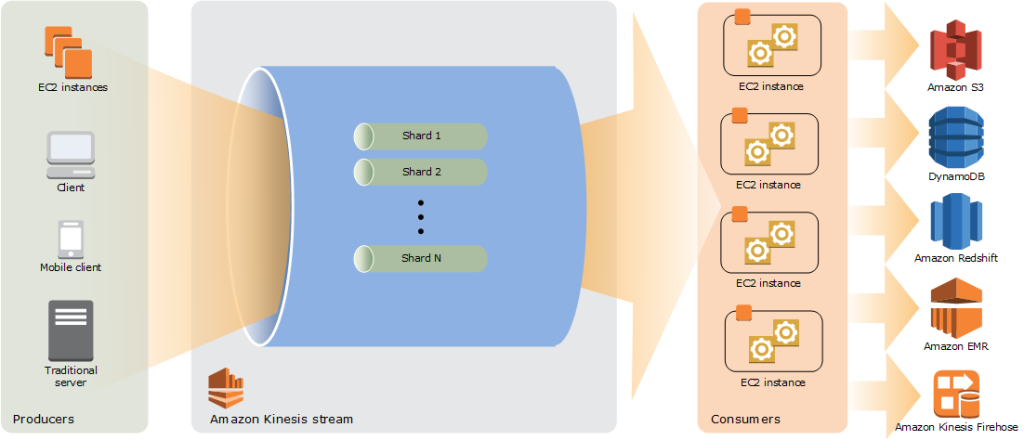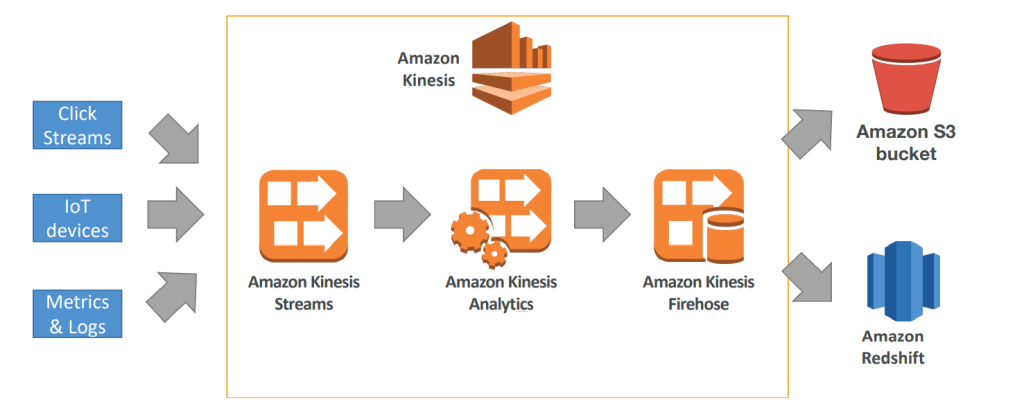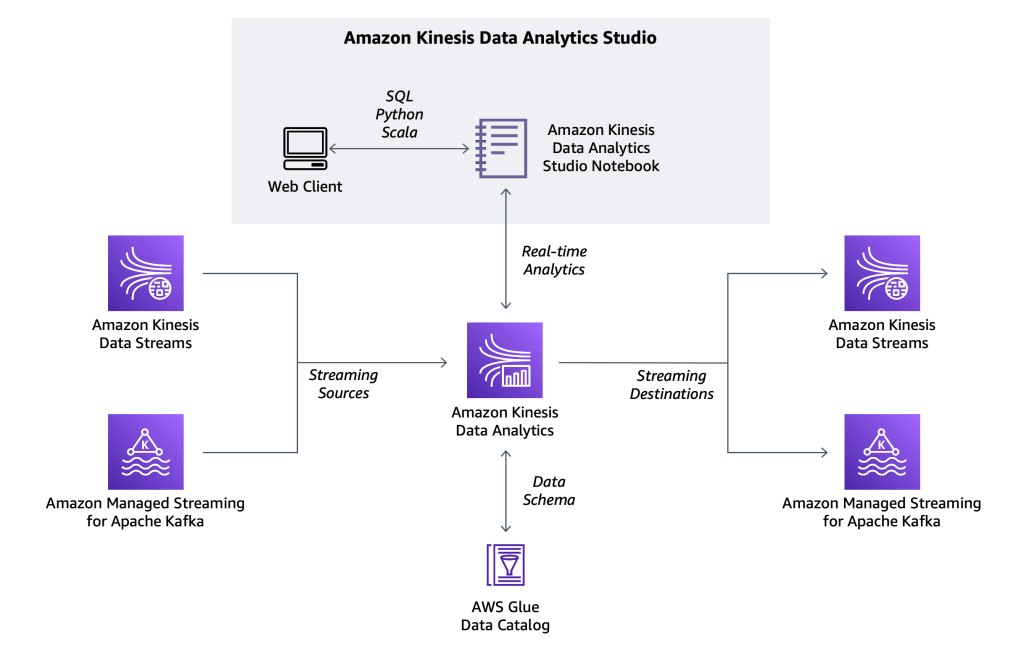
 Understanding Amazon Kinesis: Real-Time Data Streaming at Scale
Understanding Amazon Kinesis: Real-Time Data Streaming at Scale
In today’s data-driven world, where information flows in real-time from applications, websites, IoT devices, and mobile apps, businesses need a powerful way to collect, process, and analyze data the moment it is generated. This is where Amazon Kinesis shines. It’s one of the most powerful tools within the AWS ecosystem that helps companies move from batch-based data processing to real-time intelligence.

 What is Amazon Kinesis?
What is Amazon Kinesis?
Amazon Kinesis is a fully managed, scalable service offered by AWS that enables you to collect, process, and analyze real-time, streaming data at massive scale. Whether you’re dealing with video streams, application logs, metrics, or IoT data, Kinesis allows you to handle this data continuously and in near real-time.
Instead of waiting for a full day or hour to analyze data (like in traditional batch processing), Kinesis allows businesses to ingest data in seconds, derive insights, and act on them almost immediately.
 Why is Amazon Kinesis Used?
Why is Amazon Kinesis Used?
Amazon Kinesis is used when businesses need low-latency data processing and analysis. As digital systems grow in complexity, the speed at which decisions are made becomes a competitive advantage. Real-time applications, predictive analytics, personalized recommendations, and dynamic pricing engines are just some of the use cases where Kinesis plays a vital role.
Some of the core reasons companies use Amazon Kinesis include:
- Real-Time Analytics: Monitor system health, fraud detection, user behavior, or product engagement in real-time.
- Ingestion of Large Volumes of Streaming Data: Collect logs, telemetry, and metrics from thousands or millions of devices.
- Data Lake Streaming: Push data directly into data lakes or data warehouses for downstream analysis.
- Machine Learning Pipelines: Feed real-time data to ML models for immediate predictions.
- Event-Driven Architectures: React to application or business events as they happen.

 How Does Amazon Kinesis Work?
How Does Amazon Kinesis Work?
At a high level, Amazon Kinesis works by creating a pipeline for data that includes the following steps:
- Data Producers: Applications, devices, or services that generate data and send it to Kinesis. Examples include mobile apps, web applications, or sensors.
- Kinesis Stream or Delivery Service: Once data enters Kinesis, it’s placed into shards (units of throughput and storage). Data stays temporarily in the stream for a configurable duration (e.g., 24 hours to 7 days).
- Data Consumers: These are applications or services that read, process, and act on the data. Consumers could be Lambda functions, EC2 apps, or other AWS services.
- Storage/Analytics Services: Processed data is stored in S3, Redshift, Elasticsearch, or analyzed using Kinesis Data Analytics or custom applications.
The architecture allows parallel processing, meaning multiple consumers can act on the same stream of data independently and simultaneously.


 Key Features of Amazon Kinesis
Key Features of Amazon Kinesis
- Real-Time Data Processing: Process data as soon as it’s produced, with minimal latency.
- Scalability: Easily handle gigabytes of data per second by adding shards or scaling delivery streams.
- Durability: Kinesis replicates your data across multiple availability zones.
- Multiple Data Consumers: More than one application can consume the same data stream simultaneously.
- Data Retention Options: Configure retention periods from 24 hours up to 365 days.
- Flexible Data Format Support: Supports JSON, CSV, AVRO, or any custom format.
- Fully Managed: No infrastructure to manage, making it easy to deploy at scale.
- Seamless AWS Integration: Works out-of-the-box with services like Lambda, S3, Redshift, Glue, and more.
 Main Components of Amazon Kinesis
Main Components of Amazon Kinesis
Amazon Kinesis consists of four core services, each tailored for different types of streaming data use cases:
1. Kinesis Data Streams (KDS)
Designed for custom, real-time applications. Developers can build their own consumers using SDKs, Lambda, or other tools. Data is stored for up to 7 days by default.
2. Kinesis Data Firehose
A fully managed service that automatically delivers streaming data to destinations like Amazon S3, Redshift, or OpenSearch. It supports optional data transformation and compression.
3. Kinesis Data Analytics
Allows users to write SQL queries or Apache Flink applications to analyze and process streaming data directly. Ideal for building dashboards or alerting systems in real time.
4. Kinesis Video Streams
Handles the ingestion, processing, and storage of video streams. Commonly used for machine learning and video analytics scenarios such as smart surveillance or visual inspection systems.
 When Should You Use Amazon Kinesis?
When Should You Use Amazon Kinesis?
You should consider using Amazon Kinesis when:
- You need to process or analyze continuous streams of data in real-time.
- Your systems generate high-frequency events, such as IoT sensors, log files, or user clickstreams.
- You want to build event-driven applications.
- You want to reduce the latency between data generation and action.
- You need to power real-time dashboards or monitoring systems.
- You’re building a modern data pipeline to feed into a data lake or data warehouse.
 Benefits of Using Amazon Kinesis
Benefits of Using Amazon Kinesis
- Speed to Insight: Analyze data in seconds, not hours or days.
- Serverless Processing: No need to provision or manage servers.
- Highly Scalable: Can ingest terabytes of data per hour.
- Reliable and Durable: Built-in data replication across availability zones.
- Low Cost of Entry: Pay-as-you-go pricing and on-demand scaling.
- Security Built-in: Supports KMS encryption, VPC, IAM roles, and more.
- Developer Friendly: SDKs available in Java, Python, Node.js, and other languages.
- Supports Custom Processing Logic: Build complex workflows and transformation pipelines.
 Limitations or Challenges of Amazon Kinesis
Limitations or Challenges of Amazon Kinesis
While Kinesis is powerful, it’s important to understand its limitations:
- Cost Can Add Up: Especially at high throughput or when storing data for longer periods.
- Learning Curve: Understanding shards, partitions, and processing windows can be challenging for newcomers.
- Latency: While near real-time, it’s not always sub-second—especially with complex transformations.
- Throughput Limits per Shard: Each shard has defined limits; scaling improperly can cause throttling.
- Operational Debugging: Troubleshooting misconfigurations in Firehose or Flink applications can be tricky.
- Retention Window: Extended retention beyond 7 days requires enabling long-term storage or pushing to S3.

 How to Get Started with Amazon Kinesis
How to Get Started with Amazon Kinesis
Getting started with Kinesis is straightforward, especially with Firehose:
Step 1: Set Up Your AWS Account
Make sure billing and IAM permissions are configured.
Step 2: Choose the Right Kinesis Service
- Use Kinesis Data Streams for custom real-time apps.
- Use Kinesis Data Firehose for automatic delivery to S3/Redshift.
- Use Kinesis Data Analytics if you want to run SQL queries.
Step 3: Configure Data Producers
- Connect your app, website, or IoT device to start sending data.
- Use AWS SDK or Kinesis Agent to send logs.
Step 4: Set Up Processing
- Create a Lambda function, Flink app, or use SQL-based analytics to process incoming data.
Step 5: Choose Destination
- Send data to S3, Redshift, Elasticsearch, or another AWS service.
Step 6: Monitor and Optimize
- Use CloudWatch for metrics, alerts, and throughput monitoring.
 Alternatives to Amazon Kinesis
Alternatives to Amazon Kinesis
Kinesis is not the only player in the stream processing game. Here are some alternatives:
| Tool | Description |
|---|---|
| Apache Kafka | Open-source distributed streaming platform. More flexible but requires management. |
| Google Cloud Pub/Sub | Serverless messaging for real-time analytics on GCP. |
| Azure Event Hubs | Real-time data ingestion at scale on Azure. |
| Confluent Cloud | Managed Apache Kafka with advanced enterprise features. |
| Apache Pulsar | Distributed pub-sub messaging system with multi-tenancy and message storage. |
Each has its own strengths. Kinesis is best for those already invested in AWS and wanting a fully managed solution.
 Real-World Use Cases and Success Stories
Real-World Use Cases and Success Stories
1. Netflix
Uses Kinesis to monitor and analyze billions of log events per day for real-time troubleshooting and insights.
2. Airbnb
Ingests and processes events from their app to personalize user experience and monitor app performance.
3. Autonomous Vehicles & IoT
Manufacturers use Kinesis to process sensor data in real-time to monitor vehicle performance and predict maintenance.
4. E-Commerce
Retailers use Kinesis to analyze clickstreams, detect fraud, and offer dynamic pricing based on real-time customer behavior.
5. Gaming Platforms
Games stream user events to Kinesis to track engagement, prevent cheating, and deliver personalized content.
 Final Thoughts
Final Thoughts
Amazon Kinesis is an essential service for businesses that want to unlock the power of real-time data. Whether you’re building event-driven applications, creating live analytics dashboards, or setting up scalable data pipelines, Kinesis provides the tools and scalability you need—without managing servers or infrastructure.
If your business demands low-latency decision-making, scalable data ingestion, and tight AWS integration, Amazon Kinesis is an excellent choice to future-proof your architecture.
I’m a DevOps/SRE/DevSecOps/Cloud Expert passionate about sharing knowledge and experiences. I am working at Cotocus. I blog tech insights at DevOps School, travel stories at Holiday Landmark, stock market tips at Stocks Mantra, health and fitness guidance at My Medic Plus, product reviews at I reviewed , and SEO strategies at Wizbrand.
Please find my social handles as below;
Rajesh Kumar Personal Website
Rajesh Kumar at YOUTUBE
Rajesh Kumar at INSTAGRAM
Rajesh Kumar at X
Rajesh Kumar at FACEBOOK
Rajesh Kumar at LINKEDIN
Rajesh Kumar at PINTEREST
Rajesh Kumar at QUORA
Rajesh Kumar at WIZBRAND
 Starting: 1st of Every Month
Starting: 1st of Every Month  +91 8409492687
+91 8409492687  Contact@DevOpsSchool.com
Contact@DevOpsSchool.com
